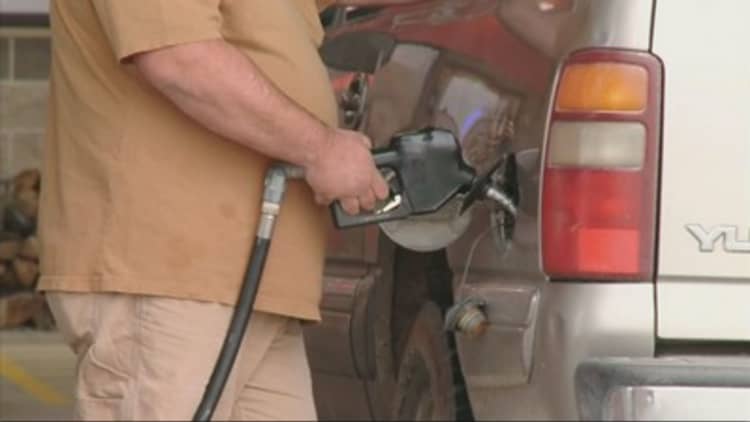
Cheap gasoline prices are about to get a lot cheaper, particularly in the Midwest.
Spot gasoline in the Midwest market was selling at a low of just under 93 cents per gallon Monday, the lowest level since March, 2009, according to Tom Kloza, global head of energy analyisis at Oil Price Information Service. The spot market is where distributors shop for product, and that should ultimately translate to a lower price for retail customers at the pump.
"Don't be surprised if you see $1.50 to $1.75 quite commonly, in that part of the country," said Kloza. The national average is currently $2.15 per gallon for unleaded gasoline, and the price in the Midwest varies by state, according to AAA data. The current average in Ohio is $2.01 while the current average in Michigan is $2.15 and Illinois is $2.17, according to AAA.
Chicago will not see the super-low prices because of its gasoline tax, Kloza said.
The Chicago spot prices were the cheapest in the U.S. on Monday, with a $1.08 price in the Gulf Coast market the second lowest. The Chicago spot market serves Illinois, Indiana, Michigan, Wisconsin, Ohio and Kentucky.
Cheaper gas at the pump could result in a savings in gasoline costs for consumers of $8.2 billion over last year in the 40 shopping days leading up to Christmas, Kloza said. The savings is more than $16 billion over 2013's level.
"Ultimately, we'll see very, very weak prices in the Rockies and the Pacific Northwest and even California; it's possible before the end of the year," said Kloza. California, which has the most expensive gas in the country, could see some gasoline at $2-a-gallon level. The California average is currently $2.80 per gallon.
The Midwest prices are also especially cheap because refiners there use Canadian sour heavy crude, about $15 per barrel cheaper than West Texas Intermediate.
Read MoreHow ISIS attacks could affect Saudi oil production
"There's certainly a lot more crude oil, and a lot more worries that the glut in crude is being transitioned into a temporary glut in gasoline. There's no place to put it. Once you manufacture too much, you have these distress sales," said Kloza. According to the International Energy Agency, there is 3 billion barrels of crude in storage globally.
Read MoreOil snaps 3-day losing streak
The Midwest this summer suffered unusually high gasoline prices relative to other regions due to an outage at BP's Whiting refinery in Indiana.
"All the refining maintenance is now over, and they're operating at high utilization rates," said Andrew Lipow, president of Lipow Oil Associates. "They're putting out more gasoline supplies at the same time demand in that part of the country (Midwest) tends to seasonally decline with the poor weather. It looks to me like we get to $2 (national average) by the end of the year."
Gasoline in the futures market, meanwhile, the U.S. produced 9.4 million barrels per day of motor gasoline last week, up from 9.2 million barrels per day the week before.
Kloza said he sees a 50/50 chance of gasoline reaching a $2-per-gallon national average.
Analysts said the days of cheap gasoline will quickly come to an end if terror attacks in Paris result in a geopolitical premium being built into crude prices. West Texas Intermediate crude futures rose 2.5 percent on the NYMEX to $41.74 per barrel Monday. Gasoline futures were flat at $1.239 per gallon.
Kloza said the terror attacks could have the opposite effect on oil prices, and drive them lower if people become afraid to travel.
Either way, gasoline prices will not stay at low prices once refiners go offline again in late winter. Prices could rise about 60 cents to 70 cents per gallon after they hit bottom this winter, Kloza said.
Correction: This story has been updated to reflect that U.S. gasoline production total was on a daily basis


